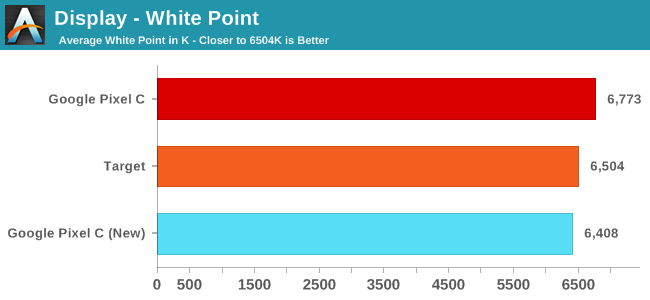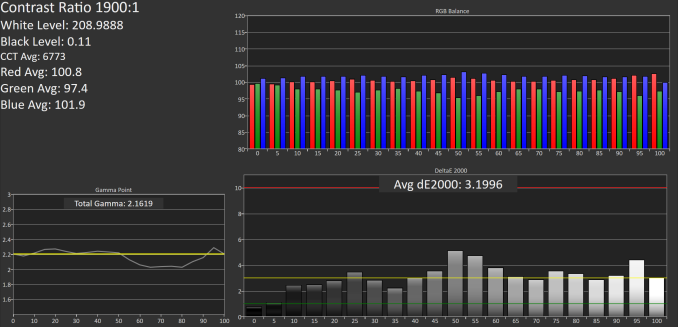Revisiting The Google Pixel C - Better, But Not There Yet
by Brandon Chester on February 17, 2016 8:01 AM ESTDisplay Comparison
Due to the nature of smartphone and tablet sampling, it's not often that we get two units of a device sent to the same reviewer. Since I already had to set this Pixel C to 200 nits for battery life testing, I figured that it would be interesting to see how the accuracy compares to the original review unit that we received. While a sample size of two is still hardly enough to make any definitive conclusions on the variance from unit to unit, it is an interesting exercise in seeing how far or how little two completely different units differ from one another. If you're looking for more commentary on the Pixel C's display I encourage you to check out the display analysis page in original review.

Something that I quickly noticed about this new Pixel C unit is that the display is warmer than the original one. This is hardly a surprise, with all mobile devices having fairly high variability with the white point. While the last one was above the standard illuminant D65, this one is a bit below. What this does imply is that Google is probably hovering around D65 with their white point target, so there doesn't appear to be a heavy shift toward the blue to improve battery life, which is something you do see on many other smartphones and tablets. The low power LTPS panel is seemingly able to keep power low enough that shifting toward blue to improve backlight efficiency isn't required to achieve good battery life.
Original Pixel C
New Pixel C

This new Pixel C performs a bit worse in our greyscale accuracy test, but the difference really isn't noticeable. In fact, the similarity between the results on both devices is almost spooky, although it really just speaks to the level of consistency Google is enforcing. Due to the green component of luminance dropping off as you move toward 100% white you see similar errors for each shade of grey. I actually tested again to make sure I hadn't accidentally tested the same unit twice, even though the differing white points made me fairly sure of that. While Google isn't giving you ridiculous levels of calibration with DeltaE values below 1, it is clear that they're fairly consistent with targeting a DeltaE of around 3 for greyscale.

Saturation accuracy drops a bit on the new Pixel C, but it's really not a big enough difference to make an impact on even highly color sensitive workflows.

In the color checker test we see that both Pixel C units have equivalent average error values. There's not much else to be said here, as both panels are at a point where further improvements to color mixture accuracy won't really bring any tangible benefit.
As I said before, two units is hardly enough to make a conclusion about Google's calibration standards. That being said, you can definitely use the data to get an idea of how tight their tolerances are. I think in this case it's clear that you'll be getting a pretty accurate display with the Pixel C, and the biggest difference will be whether your white point leans more toward red or blue.












67 Comments
View All Comments
polygon_21 - Wednesday, February 17, 2016 - link
Very very disappointing from GoogleImSpartacus - Wednesday, February 17, 2016 - link
Yeah, I feel like there's a story behind this that we might never get to truly learn. Very odd.parzival - Wednesday, February 17, 2016 - link
Try checking this out.http://arstechnica.com/gadgets/2015/12/the-pixel-c...
CurbedLarry - Wednesday, February 17, 2016 - link
Google is behaving like the US auto industry in the 70sWe're number 1, we can put out any old trash and people will still buy it
kurkosdr - Monday, March 21, 2016 - link
Or was it Nvidia? Most of the bugs seem driver-related. Stay away from any Android device featuring a Nvidia SoC. Nvidia chips almost killed LG. You 've been warned. Fortunately there aren't many Nvidia-powered devices them around, but Google still wants to throw them a bone once in a while to shake the Qualdroid stigma inthe hi-end segment, so you occasionally see an Nvidia chip shoved in a Nexus/Pixel tablet. Always the last Nexus to get updates or doesn't get them correctlypsychobriggsy - Wednesday, February 17, 2016 - link
Google needs to learn that sometimes you just need to can a product, even if it's 90% complete and otherwise quite nice. Android is just a shitty tablet OS.jabber - Wednesday, February 17, 2016 - link
Either that or you just put the release back another couple of months to get it 99% right rather than 75%. People will wait for a finished/fully working product.xthetenth - Wednesday, February 17, 2016 - link
That goes double or triple for a tablet that puts that much of its weight budget into and focuses so hard on its keyboard. The only OS that would make sense with that hardware is W10 (after a nub mouse was added). Even iOS is coming at it from a different direction that would make a hypothetical iPixel C a conflicted mess. An OS that's limited to tablets as oversized phones and a keyboard that's more than a sixth or so the overall weight of the device can not work together and should not be tried. For reference it's more biased towards the keyboard than the Surface line, and those run a full desktop OS.Honestly this and the OS in general is making me sad again that Android has done well.
xenol - Wednesday, February 17, 2016 - link
Well the good thing about Android is it's open source and free software. So some people went out of their way of creating a more proper desktop based OS that fits this formfactor: http://www.jide.com/en/remixosxthetenth - Wednesday, February 17, 2016 - link
That would be a good bit closer to right, and I'd consider the device with that, although I'd likely want W10.